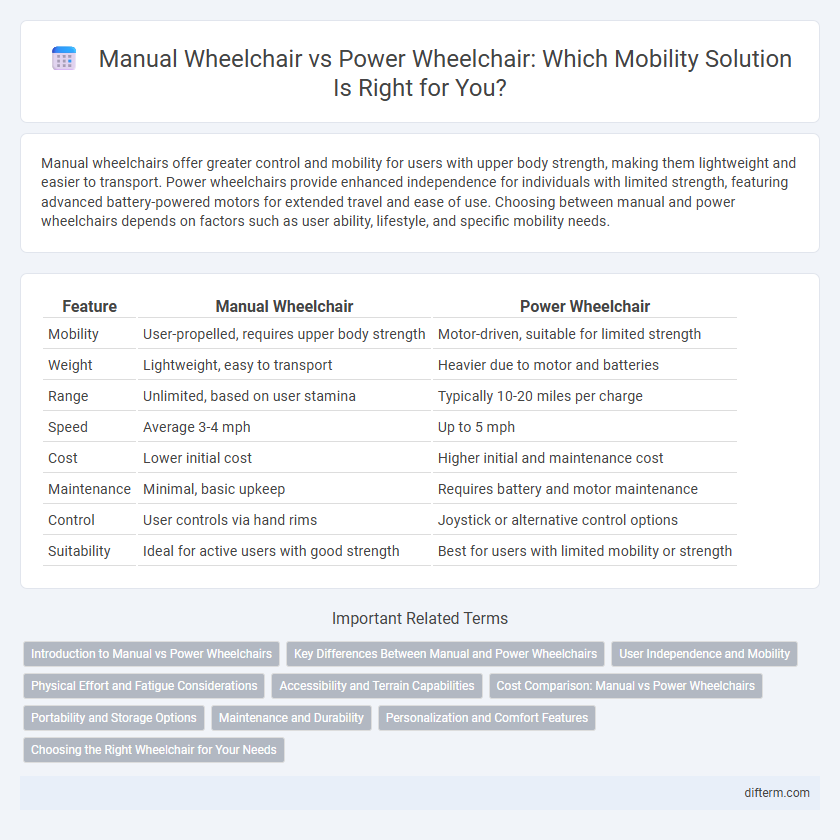Manual wheelchairs offer greater control and mobility for users with upper body strength, making them lightweight and easier to transport. Power wheelchairs provide enhanced independence for individuals with limited strength, featuring advanced battery-powered motors for extended travel and ease of use. Choosing between manual and power wheelchairs depends on factors such as user ability, lifestyle, and specific mobility needs.
Table of Comparison
| Feature | Manual Wheelchair | Power Wheelchair |
|---|---|---|
| Mobility | User-propelled, requires upper body strength | Motor-driven, suitable for limited strength |
| Weight | Lightweight, easy to transport | Heavier due to motor and batteries |
| Range | Unlimited, based on user stamina | Typically 10-20 miles per charge |
| Speed | Average 3-4 mph | Up to 5 mph |
| Cost | Lower initial cost | Higher initial and maintenance cost |
| Maintenance | Minimal, basic upkeep | Requires battery and motor maintenance |
| Control | User controls via hand rims | Joystick or alternative control options |
| Suitability | Ideal for active users with good strength | Best for users with limited mobility or strength |
Introduction to Manual vs Power Wheelchairs
Manual wheelchairs offer increased portability and require upper body strength for propulsion, making them suitable for individuals seeking active mobility and outdoor use. Power wheelchairs provide enhanced independence through motorized controls, ideal for users with limited upper body strength or long-distance travel needs. Both types prioritize user comfort and functionality but differ significantly in maintenance, weight, and maneuverability.
Key Differences Between Manual and Power Wheelchairs
Manual wheelchairs require physical effort for propulsion, making them lightweight and easier to maneuver in tight spaces. Power wheelchairs rely on battery-powered motors, offering increased independence and reduced physical strain for users with limited upper body strength. Key differences include weight capacity, maintenance requirements, and typical usage environments, with power wheelchairs suited for longer distances and uneven terrain.
User Independence and Mobility
Manual wheelchairs enhance user independence by promoting physical activity and upper body strength, allowing individuals to navigate varied terrains with skill and control. Power wheelchairs significantly increase mobility options for users with limited strength or endurance, enabling longer travel distances and easier navigation through complex environments. Selecting between manual and power wheelchairs depends on the user's physical capabilities, lifestyle needs, and desire for autonomy in daily activities.
Physical Effort and Fatigue Considerations
Manual wheelchairs require significant upper body strength and continuous physical effort, often leading to increased fatigue and strain on the shoulders, arms, and wrists over time. Power wheelchairs, equipped with electric motors, minimize physical exertion by allowing users to navigate independently without constant propulsion, greatly reducing fatigue. Choosing between the two depends on the user's physical capabilities, endurance levels, and the need to conserve energy during daily mobility activities.
Accessibility and Terrain Capabilities
Manual wheelchairs offer greater accessibility in tight indoor spaces due to their lightweight design and easier maneuverability, making them ideal for everyday use in homes and public buildings. Power wheelchairs excel in handling various terrains such as uneven sidewalks, gravel paths, and inclines, thanks to their motorized propulsion and advanced suspension systems. Terrain adaptability in power wheelchairs significantly enhances outdoor mobility compared to manual models, which require more physical effort and skill to navigate rough surfaces.
Cost Comparison: Manual vs Power Wheelchairs
Manual wheelchairs typically cost between $150 and $1,000, making them an affordable mobility option for many users. Power wheelchairs, however, range from $1,500 to $15,000 or more, reflecting their advanced features and battery-powered operation. Insurance coverage and maintenance expenses also vary significantly, with power wheelchairs often requiring higher ongoing costs.
Portability and Storage Options
Manual wheelchairs are lightweight and foldable, making them highly portable and easy to store in compact spaces such as car trunks or closets. Power wheelchairs, although heavier and bulkier due to their motor and battery components, often feature detachable parts or foldable frames to improve transportability. Choosing between the two depends on balancing mobility needs with storage constraints, where manual wheelchairs excel in portability while power wheelchairs prioritize ease of use over compact storage.
Maintenance and Durability
Manual wheelchairs require less maintenance due to their simpler mechanical structure but may experience wear on tires and bearings from frequent use. Power wheelchairs, with complex electrical components and motorized parts, demand regular battery care, motor inspections, and potential software updates to maintain optimal performance. Durable materials such as aircraft-grade aluminum or titanium frames enhance longevity in both types, but power wheelchairs generally have higher long-term maintenance costs due to their advanced technology.
Personalization and Comfort Features
Manual wheelchairs offer customizable seating options, including adjustable cushions and backrests, to enhance user comfort and support tailored to individual body shapes. Power wheelchairs provide advanced personalization with features like programmable joystick sensitivity, reclining functions, and pressure relief systems that adapt to the user's mobility needs. Both types incorporate ergonomic designs, but power wheelchairs excel in offering automated comfort adjustments for prolonged use.
Choosing the Right Wheelchair for Your Needs
Selecting the right wheelchair depends on individual mobility, strength, and lifestyle requirements. Manual wheelchairs offer greater portability and independence for users with sufficient upper body strength, while power wheelchairs provide enhanced mobility and ease for those with limited physical ability or long-distance travel needs. Evaluating factors such as terrain, frequency of use, and personal comfort is essential to ensure optimal functionality and support.
manual wheelchair vs power wheelchair Infographic

 difterm.com
difterm.com